Shear Analysis of “Concrete-to-Concrete” Contact as an Important Parameter for Strengthening Concrete Structures
Abstract
1. Introduction
- -
- The need to increase the load-bearing capacity or seismic resistance of the structure due to an increase in the load for which the original structure was not designed;
- -
- The design or constructional failures;
- -
- The failures during operation (e.g., failure of concrete or reinforcement due to corrosion, fire, or other extraordinary loads [26]).
- -
- Cohesion;
- -
- Friction;
- -
- Shear reinforcement (connectors).
| Type of Modification | c [MPa] STN EN 1992-1-1 (2004) [57] | c [MPa] STN EN 1992-1-1 (2015) [6] | c [MPa] prEN 1992-1-1 (2023) [58] |
|---|---|---|---|
| Very smooth | 0.25 | 0.025 | 0.0095 |
| Smooth | 0.35 | 0.20 | 0.075 |
| Rough | 0.45 | 0.40 | 0.19 |
| Indented | 0.50 | 0.50 | 0.37 |
- -
- Mechanical bonding;
- -
- Physical bonding;
- -
- Chemical bonding.
- FT is the frictional force parallel to the sliding surface [kN];
- μ is the coefficient of shear friction [-];
- FN is the pressing force perpendicular to the sliding surface [kN].
2. Experimental Program
3. Results of the Experimental Measurements
4. Evaluation of the Experimental Program and Discussion
4.1. Smooth Surface
4.2. Indents
4.3. Notches
4.4. Fibreconcrete—Notches
5. Conclusions
Author Contributions
Funding
Data Availability Statement
Acknowledgments
Conflicts of Interest
References
- Maulana, H.; Thamrin, R.; Kurniawan, R.; Haris, S.; Nabila, W.U.; Syaifa, L. Seismic Behavior of Reinforced Concrete Beam-Column Joints Strengthened with Varied Installation Length of CFRP Sheets. Civ. Environ. Eng. 2025, 21, 409–426. [Google Scholar] [CrossRef]
- Sbahieh, S.; Rabie, M.; Ebead, U.; Al-Ghamdi, S.G. The Mechanical and Environmental Performance of Fiber-Reinforced Polymers in Concrete Structures: Opportunities, Challenges and Future Direction. Buildings 2022, 12, 1417. [Google Scholar] [CrossRef]
- Nguyen, H.Q.; Kim, J.K. A Theoretical and Numerical Approach to Ensure Ductile Failure in Strengthened Reinforced Concrete Slabs with Fiber-Reinforced Polymer Sheets. Buildings 2025, 15, 831. [Google Scholar] [CrossRef]
- Qassim, H.J.; Mashrei, M.A. Flexural Strength of RC Continuous Beams Strengthened by CFRP Using EBR and EBROG Methods: Experimental and Analytical Study. Civ. Environ. Eng. 2024, 20, 580–592. [Google Scholar] [CrossRef]
- Prignc, S.; Bahleda, F. Strengthening of Concrete Members, 1st ed.; Technical University of Košice: Košice, Slovakia, 2007. [Google Scholar]
- STN EN 1992-1-1 (73 1201); Design of Concrete Structures—Part 1-1: General Rules and Rules for Buildings. SUTN: Bratislava, Slovakia, 2015.
- Hasan, A.T.; Mashrei, M.A.; Makki, J.S. Behavior of Circular Reinforced Concrete Columns Strengthened by Different Techniques Subjected to Axial Loading. Civ. Environ. Eng. 2024, 20, 319–331. [Google Scholar] [CrossRef]
- Kolchunov, V.I.; Fedorova, N.V.; Savi, S.Y.; Kaydas, P.A. Progressive Collapse Behavior of a Precast Reinforced Concrete Frame System with Layered Beams. Buildings 2024, 14, 1776. [Google Scholar] [CrossRef]
- Valašík, A.; Benko, V.; Strauss, A.; Täubling, B. Reliability assessment of slender concrete columns at the stability failure. In Proceedings of the Computer Methods in Mechanics (CMMM 2017), 22nd International Conference on Computer Methods in Mechanics, Lublin, Poland, 13–16 September 2017; Volume 1922, p. 130010. [Google Scholar]
- Tomica, V.; Sokolík, A.; Zemko, Š. Maintenance and Reconstruction of Bridges, 1st ed.; ALFA: Bratislava, Slovakia, 1992. [Google Scholar]
- Kralovanec, J.; Moravcik, M. Experimental measurements in the field of prestressing force monitoring. Civ. Environ. Eng. 2022, 18, 104–110. [Google Scholar] [CrossRef]
- Brindha, U.; Maheswaran, J.; Chellapandian, M.; Arunachela, N. Quantitative Assessment of Strengthening Strategies and Design Recommendations for the Repair of Corrosion-Damaged Reinforced Concrete Member. Buildings 2023, 13, 1080. [Google Scholar] [CrossRef]
- Dongyun, L.; Wang, C.; Gonzalez-Libreros, J.; Tong, G.; Cao, J.; Youngming, T.; Lennart, E.; Gabriel, S. A review of concrete properties under the combined effect of fatigue and corrosion from a material perspective. Constr. Build. Mater. 2023, 369, 130489. [Google Scholar] [CrossRef]
- Han, T.; Ji, J.; Dong, Z.; Zhu, H.; Wu, G. Compression behavior of concrete columns strengthened by a hybrid BFRP/HDPE tube coupled with a crumb rubber concrete cladding layer. Constr. Build. Mater. 2023, 364, 129969. [Google Scholar] [CrossRef]
- Moravčík, M.; Kraľovanec, J. Determination of prestress losses in existing pre-tensioned structures using Bayesian approach. Materials 2022, 15, 3548. [Google Scholar] [CrossRef]
- Koteš, P.; Prokop, J.; Farbák, M.; Vavruš, M.; Gago, F.; Zahuranec, M. Report on Bridge Diagnostics in Lučenec—Bridge Diagnostics for Pedestrians MRO—Lučenec Rúbanisko II; Faculty of Civil Engineering, University of Žilina: Žilina, Sovakia, 2021. [Google Scholar]
- Koteš, P.; Vičan, J. Reliability-based evaluation of existing concrete bridges in Slovakia according to Eurocodes. In Proceedings of the Fourth International fib Congress 2014, Improving Performance of Concrete Structures”, Mumbai, India, 10–14 February 2014; pp. 227–229. [Google Scholar]
- Jiang, B.; Qian, Z.; Gu, D.; Pan, J. Repair concrete structures with high-early-strength engineered cementitious composites (HES-ECC): Material design and interfacial behavior. J. Build. Eng. 2023, 68, 106060. [Google Scholar] [CrossRef]
- Li, X.; Wang, M.; Zheng, D.; Fang, H.; Wang, F.; Wan, J. Study on the failure mechanism between polyurethane grouting material and concrete considering the effect of moisture by digital image correlation. J. Build. Eng. 2023, 67, 105948. [Google Scholar] [CrossRef]
- Saud, D.I.; Habra, S.I. Behavior of Lightweight Reinforced Concrete Concavely-Curved Soffit Beams Strengthened with CFRP. Civ. Environ. Eng. 2025, 21, 91–108. [Google Scholar] [CrossRef]
- Jo, M.S.; Kim, H.G.; Kim, D.H.; Choi, J.H.; Kim, K.H. Prediction of Flexural Strength of RC Circular Columns Considering Lateral Confinement Effects of FRCM and Transverse Steel Reinforcement. Buildings 2023, 13, 2361. [Google Scholar] [CrossRef]
- Dewi, S.H.; Thamrin, R.; Haris, S.; Yastari, F.P. Tensile Forces Behavior on Longitudinal Reinforcement and CFRP Strips on Circular Hollow Reinforced Concrete Columns. Civ. Environ. Eng. 2024, 20, 86–97. [Google Scholar] [CrossRef]
- Vavruš, M.; Koteš, P. Numerical comparison of concrete columns strengthened with layer of fibre concrete and reinforced concrete. Transp. Res. Procedia 2019, 40, 920–926. [Google Scholar] [CrossRef]
- Koteš, P.; Farbák, M. Investigation of dynamically loaded RC T-beams strengthened with CFRP lamellas and sheets. In Proceedings of the 7th International Conference on FRP Composites in Civil Engineering (CICE 2014), Vancouver, BC, Canada, 20–22 August 2014. [Google Scholar]
- Gajdošová, K.; Bilčík, J. Full-Scale Testing of CFRP-Strengthened Slender Reinforced Concrete Columns. J. Compos. Constr. 2013, 17, 239–248. [Google Scholar] [CrossRef]
- Bolina, L.F.; München, M.R.; Lago, D.B.; Kodur, V. A comparative study between ultra-high-performance concrete structures and normal strength concrete structures exposed to fire. Structures 2024, 68, 107197. [Google Scholar] [CrossRef]
- Koteš, P.; Vičan, J.; Nikolič, R. Evaluation of Elder and Historical Bridges. Procedia Eng. 2016, 156, 186–190. [Google Scholar] [CrossRef][Green Version]
- Koteš, P.; Vičan, J. Recommended Reliability Levels for the Evaluation of Existing Bridges According to Eurocodes. Struct. Eng. Int. 2013, 23, 411–417. [Google Scholar] [CrossRef]
- Gocál, J.; Odrobiňák, J. On the Influence of Corrosion on the Load-Carrying Capacity of Old Riveted Bridges. Materials 2020, 13, 717. [Google Scholar] [CrossRef]
- Moravčík, M.; Bahleda, F.; Jošt, J. Application of Indirect Methods for Determining State of Prestressing in the Structure. In Proceedings of the Conference: Concrete Days 2018, Prague, Czech Republic, 8–9 November 2018. (In Slovak). [Google Scholar]
- Hameed, M.O.; Daud, R.A. Behavior of Fatigue Damaged Reinforced Concrete One-Way Slabs Repaired with CFRP Sheets. Civ. Environ. Eng. 2024, 20, 364–376. [Google Scholar] [CrossRef]
- Kotes, P.; Farbak, M.; Kotula, P.; Brodnan, M.; Cavojcova, A. Using CFRP Lamellas for Strengthening of Dynamically Loaded Beams. Procedia Eng. 2013, 65, 302–310. [Google Scholar] [CrossRef]
- Fernandes, H.; Lúcio, V.; Ramos, A. Strengthening of RC slabs with reinforced concrete overlay on the tensile face. Eng. Struct. 2017, 132, 540–550. [Google Scholar] [CrossRef]
- Selejdak, J.; Blikharskyy, Y.; Khmil, R.; Blikharskyy, Z. Calculation of Reinforced Concrete Columns Strengthened by CFRP. In Proceedings of the Advances in Resource-Saving Technologies and Materials in Civil and Environmental Engineering (CEE 2019), 17th International Conference, Algiers, Algeria, 11–13 September 2019; pp. 400–410. [Google Scholar]
- Gago, F.; Valletta, A.; Muzik, J. Formulation of a basic constitutive model for fine-grained soils using the hypoplastic framework. Civ. Environ. Eng. 2021, 17, 450–455. [Google Scholar] [CrossRef]
- Gosztola, D.; Cucuzza, R.; Szép, J.; Domaneschi, M.; Ghodousian, O.; Rad, M.M. Plastic Limited Numerical Modelling on Contact Friction Effect of Steel–Concrete Connection for Composite Bridges. Buildings 2024, 14, 2898. [Google Scholar] [CrossRef]
- Wu, Y.; Hu, S.; Li, M.; Rong, B. Flexural Behavior of Wet Joints with Contact U-Bars. Buildings 2025, 15, 855. [Google Scholar] [CrossRef]
- Pierre-Claude, A. High-Performance Concrete, 1st ed.; CRC Press: Boca Raton, FL, USA, 1998; 624p. [Google Scholar]
- Sadowski, L. Adhesion in Layered Cement Composites, 1st ed.; Springer: Cham, Switzerland, 2019. [Google Scholar]
- Bujnakova, P.; Kralovanec, J.; Perkowski, Z. Verification of Precast Concrete Girder Bridge Under Static Load. Civ. Environ. Eng. 2022, 18, 760–767. [Google Scholar] [CrossRef]
- Kralovanec, J.; Moravcik, M.; Bahleda, F.; Prokop, J. Experimental and Numerical Study of Saw-cut Method on Concrete Beams. In Proceedings of the FIB Symposium 2021, Concrete Structures: New Trends for Eco-Efficiency and Performance, Virtual, 14–16 June 2021. [Google Scholar]
- Alnemrawi, B.R.; Al-Rousan, R. NLFEA Behavior of Heat-Damaged Key Joints in Precast Concrete Segmental Bridge. Buildings 2025, 15, 1890. [Google Scholar] [CrossRef]
- Luu, X.B.; Kim, S.K. Finite Element Modeling of Interface Behavior between Normal Concrete and Ultra-High Performance Fiber-Reinforced Concrete. Buildings 2023, 13, 950. [Google Scholar] [CrossRef]
- El-Khier, M.A.; Morcous, G. Friction and Cohesion Interface Shear Factors of Ultra-High-Performance Concrete (UHPC) Cast on Hardened Conventional Concrete. Buildings 2023, 13, 1253. [Google Scholar] [CrossRef]
- Vavruš, M.; Koteš, P.; Bahleda, F.; Jošt, J. Analysis of shear behavior between old concrete and fiber concrete. Pollack Period. 2019, 16, 77–82. [Google Scholar] [CrossRef]
- Čítek, D.; Huňka, P.; Řeháček, S.; Mandlík, T.; Kolísko, J. Testing of bond behavior of UHPC. In Proceedings of the 11th International Conference on Special Concrete and Composites, Dresden, Germany, 15–18 September 2024; pp. 95–98. [Google Scholar]
- Bonaldo, E.; Barros, J.A.; Lourenco, P.B. Bond characterization between concrete substrate and repairing SFRC using pull-off testing. Int. J. Adhes. Adhes. 2005, 25, 463–474. [Google Scholar] [CrossRef]
- Júlio, E.N.; Branco, F.A.; Silva, V.D.; Lourenço, J.F. Influence of added concrete compressive strength on adhesion to an existing concrete substrate. Build. Environ. 2006, 41, 1934–1939. [Google Scholar] [CrossRef]
- Eduardo, N.B.S.J.; Fernando, A.B.B.; Vítor, D.S. Concrete-to-concrete bond strength. Influence of the roughness of the substrate surface. Constr. Build. Mater. 2004, 18, 675–681. [Google Scholar] [CrossRef]
- Mohamad, M.E.; Ibrahim, I.S.; Abdullah, R.; Rahman, A.B.A.; Kueh, A.B.H.; Usman, J. Friction and cohesion coefficients of composite concrete-to-concrete bond. Cem. Concr. Compos. 2015, 56, 1–14. [Google Scholar] [CrossRef]
- Perez, F.; Morency, M.; Bissonnette, B.; Courard, L. Correlation between the roughness of substrate surface and the debonding risk. In Concrete Repair, Rehabilitation and Retrofitting II; CRC Press: Boca Raton, FL, USA, 2008; pp. 347–356. [Google Scholar] [CrossRef]
- Sadeghain, A.; Shaghaghi, M.T.; Mohammadi, Y.; Taghipoor, H. Performance Assessment of Hybrid Fibre-Reinforced Concrete (FRC) under Low-Speed Impact: Experimental Analysis and Optimized Mixture. Shock. Vib. 2023, 2023, 7110987. [Google Scholar] [CrossRef]
- Afandi, M.E.; Yehia, S.; Landolsi, T.; Qaddoumi, N.; Elchalakani, M. Concrete-to-concrete bond Strength: A review. Constr. Build. Mater. 2023, 363, 129820. [Google Scholar] [CrossRef]
- Adams, R.D.; Drinkwater, B.W. Nondestructive testing of adhesively-bonded joints. NDT E Int. 1997, 30, 93–98. [Google Scholar] [CrossRef]
- Halicka, A. Influence new-to-old concrete interface qualities on the behaviour of support zones of composite concrete beams. Constr. Build. Mater. 2011, 25, 4072–4078. [Google Scholar] [CrossRef]
- Tayeh, B.A.; Bakar, B.A.; Johari, M.M.; Ratnam, M.M. The relationship between substrate roughness parameters and bond strength of ultra high-performance fiber concrete. J. Adhes. Sci. Technol. 2013, 27, 1790–1810. [Google Scholar] [CrossRef]
- STN EN 1992-1-1 (73 1201); Design of Concrete Structures—Part 1-1: General Rules and Rules for Buildings. SUTN: Bratislava, Slovakia, 2004.
- prEN 1992-1-1; Design of Concrete Structure—Part 1-1: General Rules and Rules for Buildings. SUTN: Bratislava, Slovakia, 2023.
- Wall, J.S.; Shrive, N.G. Factors affecting bond between new and old concrete. ACI Mater. J. 2011, 108, 449–456. [Google Scholar] [CrossRef]
- Farouk, A.I.B.; Rong, W.; Zhu, J. Compressive behavior of ultra-high-performance-normal strength concrete (UHPC-NSC) column with the longitudinal grooved contact surface. J. Build. Eng. 2023, 68, 106074. [Google Scholar] [CrossRef]
- Santos, P.M.D.; Julio, E.N.B.S.; Vítor, D.S. Correlation between concrete-to-concrete bond strength and roughness of the substrate surface. Constr. Build. Mater. 2007, 21, 1688–1695. [Google Scholar] [CrossRef]
- Vandewalle, L.; Nemegeer, D.; Balazs, L.; Barr, B.; Barros, J.; Bartos, P.; Banthia, N.; Criswell, M.; Denarie, E.; Di Prisco, M.; et al. RILEM TC 162-TDF (2003): Test and design methods for steel fibre reinforced concrete. σ-ε design method. Final Recommendation. Mater. Struct. 2003, 36, 560–567. [Google Scholar]
- Vítek, J.L.; Smiřinský, S. Interaction of traditional reinforcement and spread reinforcement. BETON-Technol. Konstr. Sanace 2010, 2, 48–52. (In Czech) [Google Scholar]
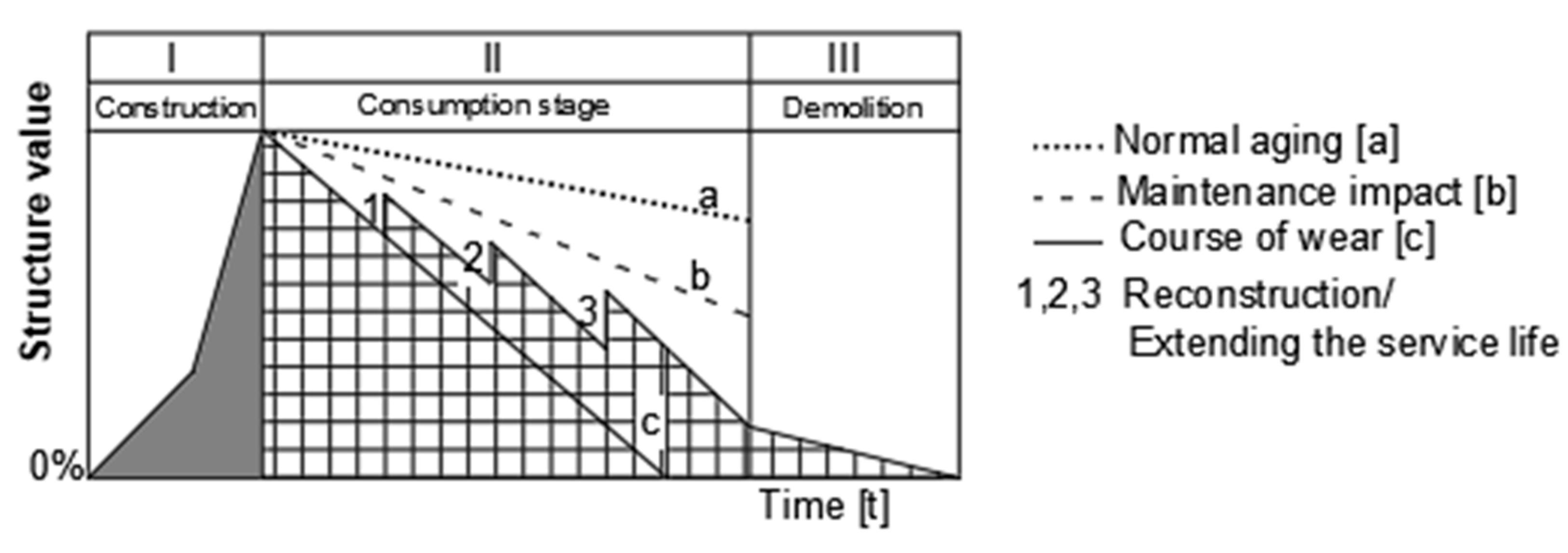
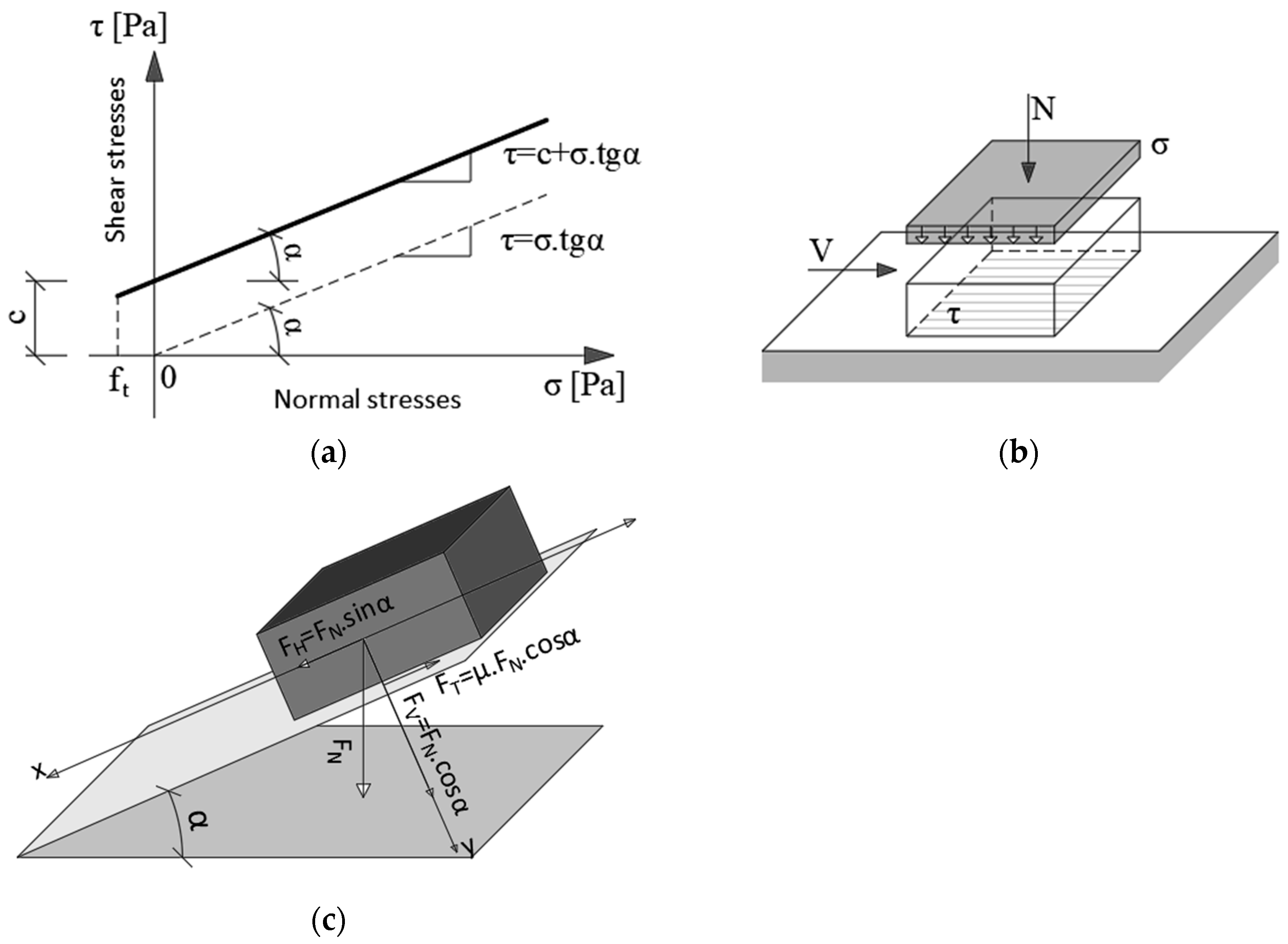
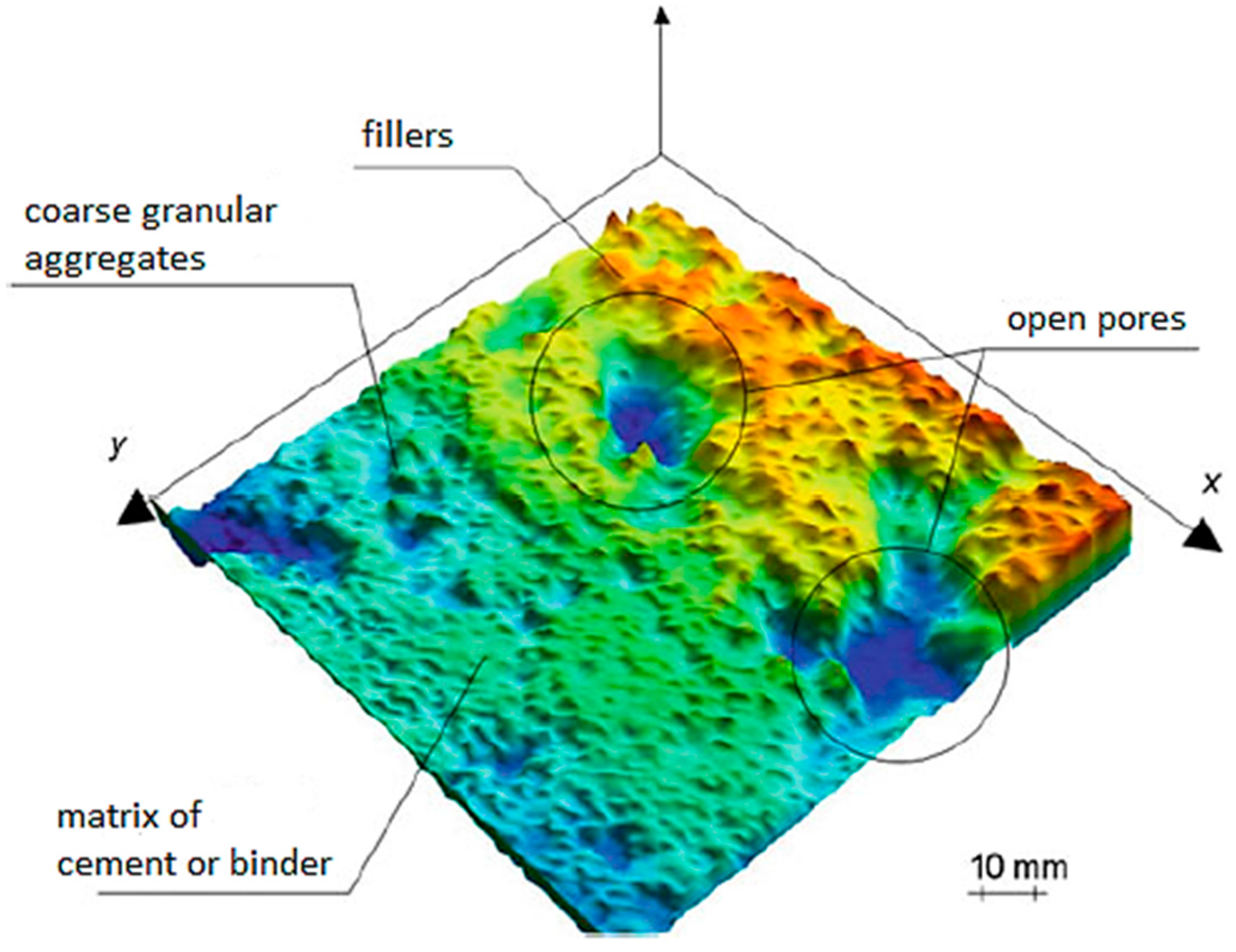
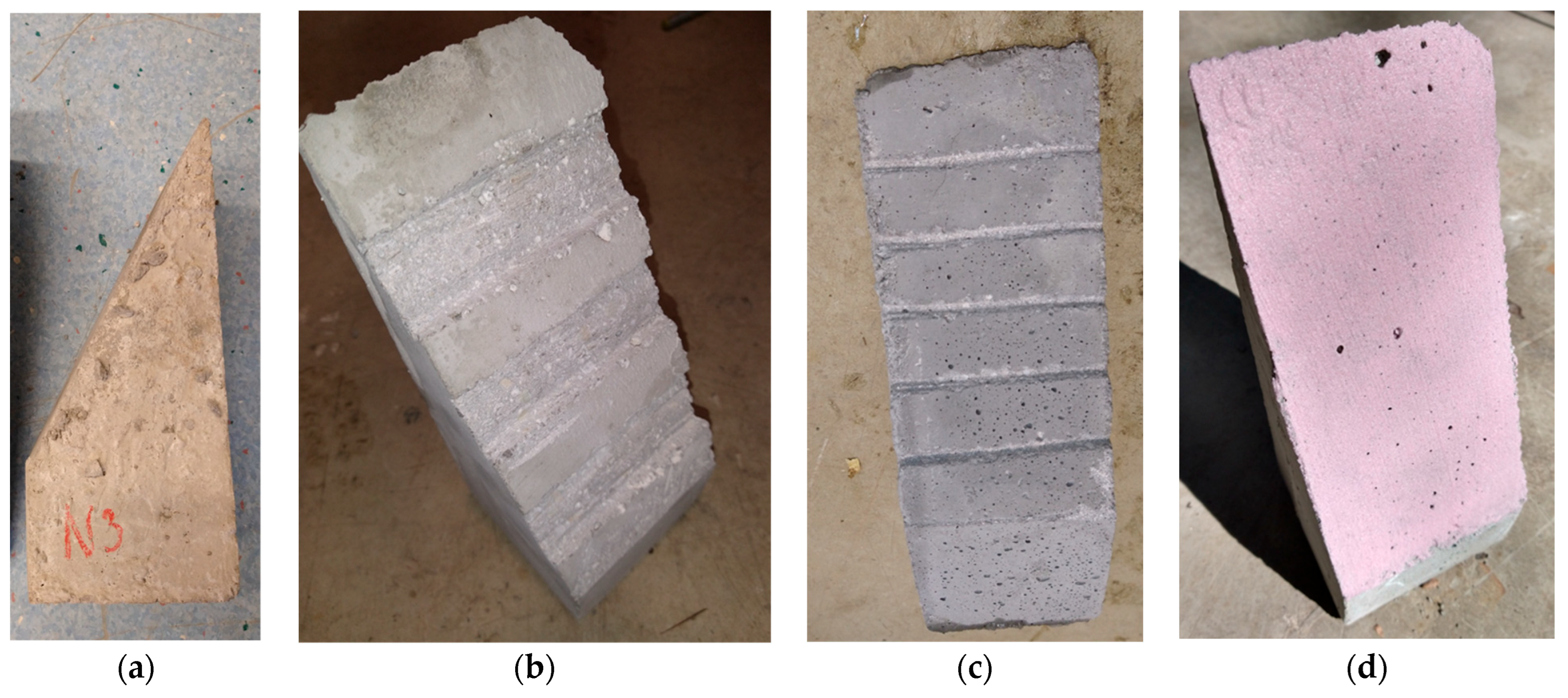
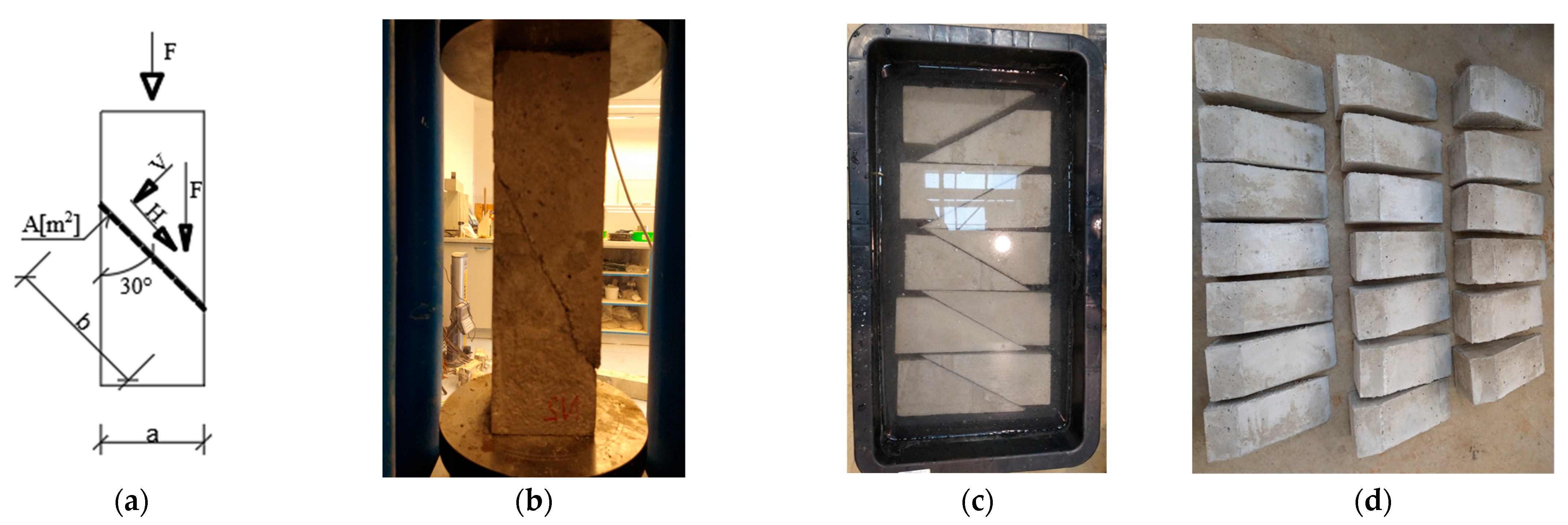
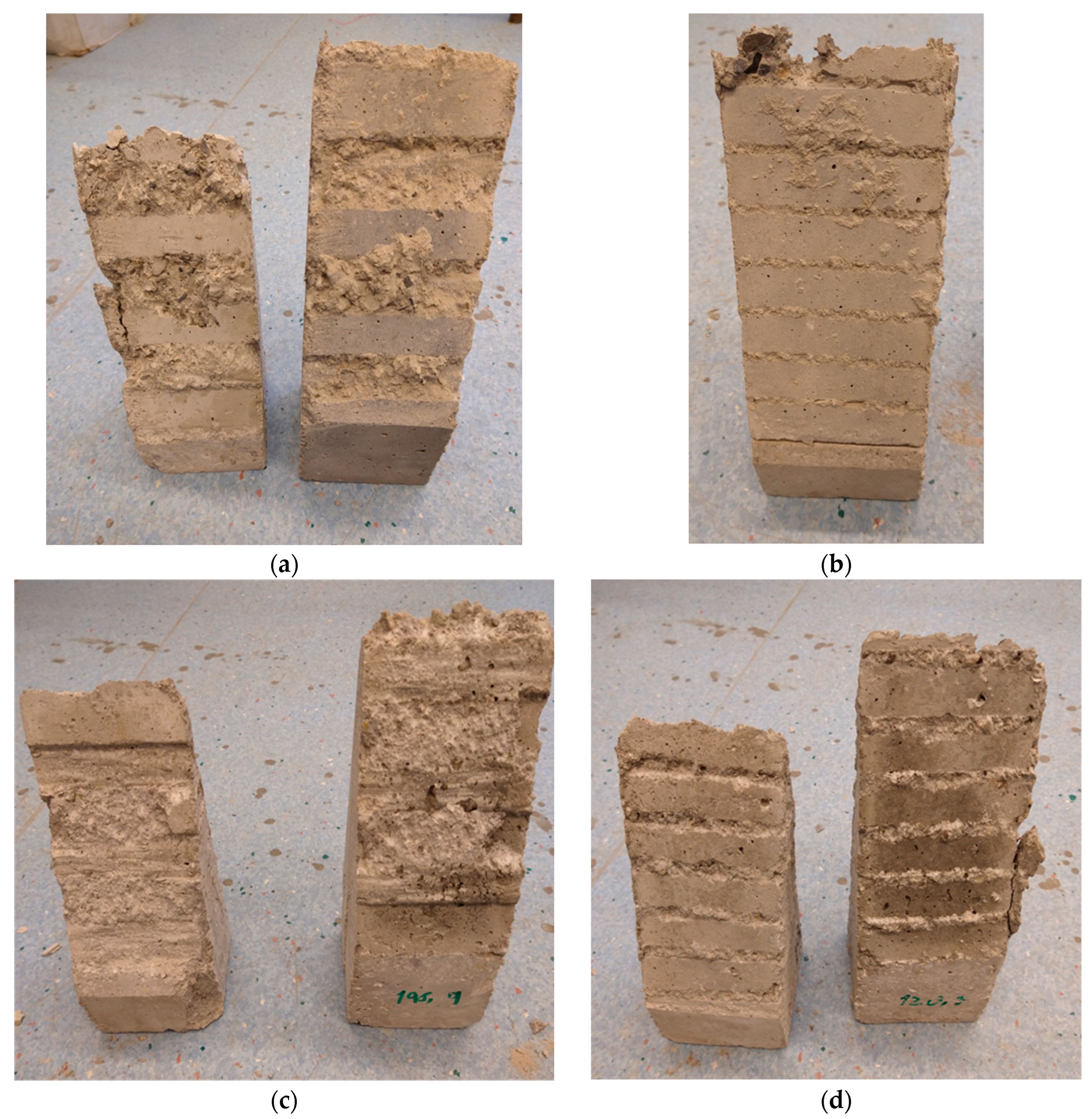
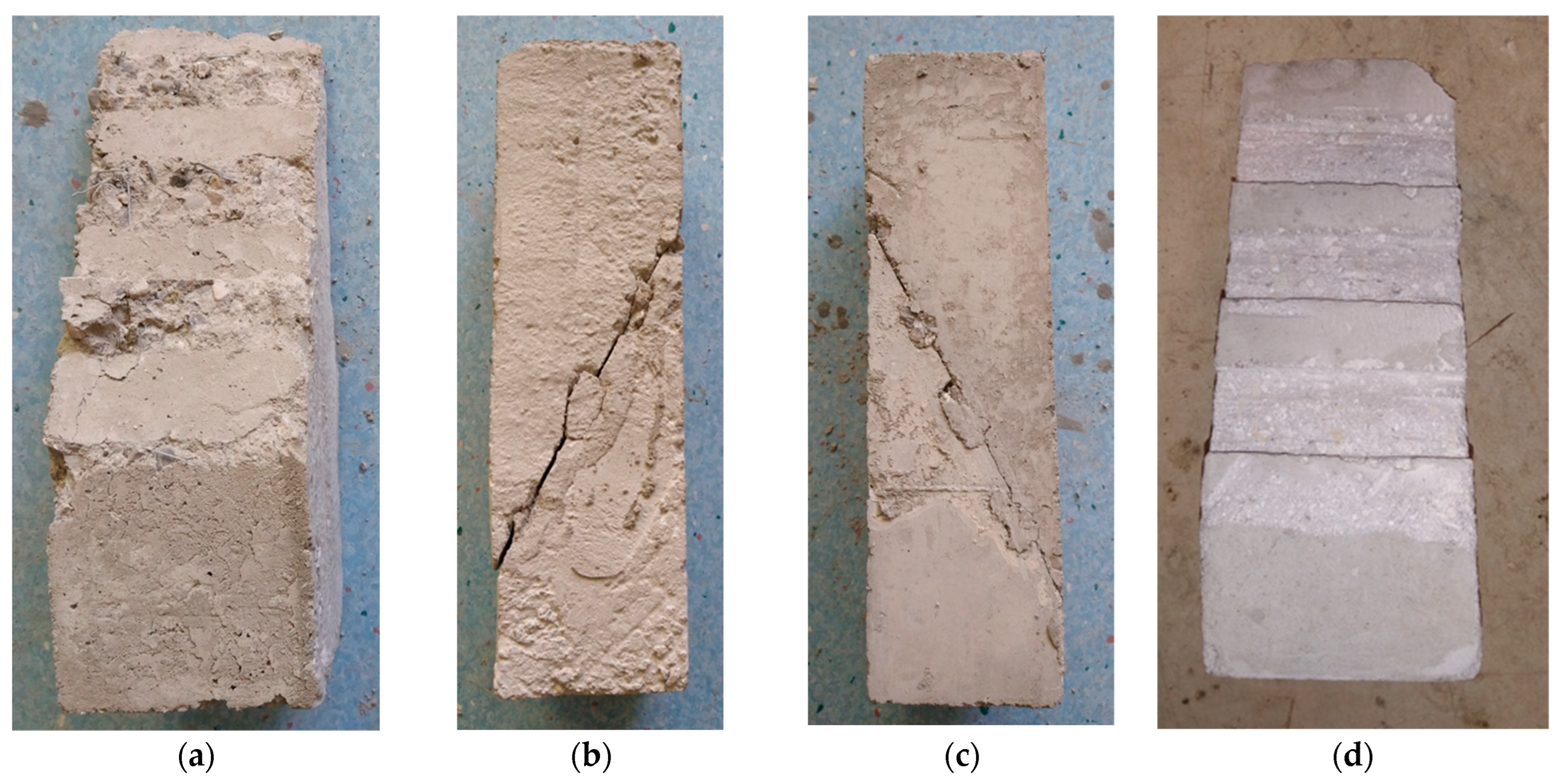

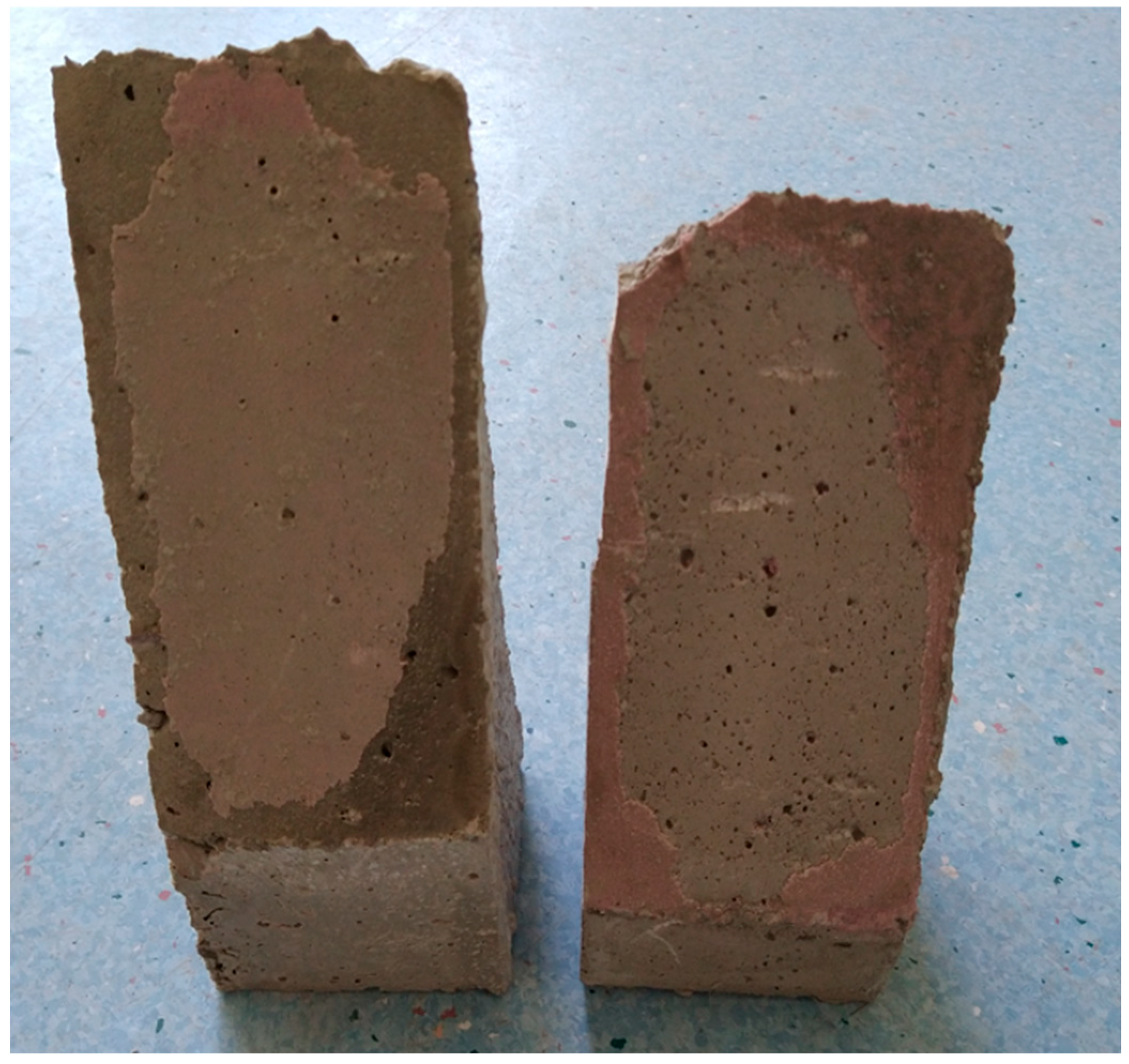
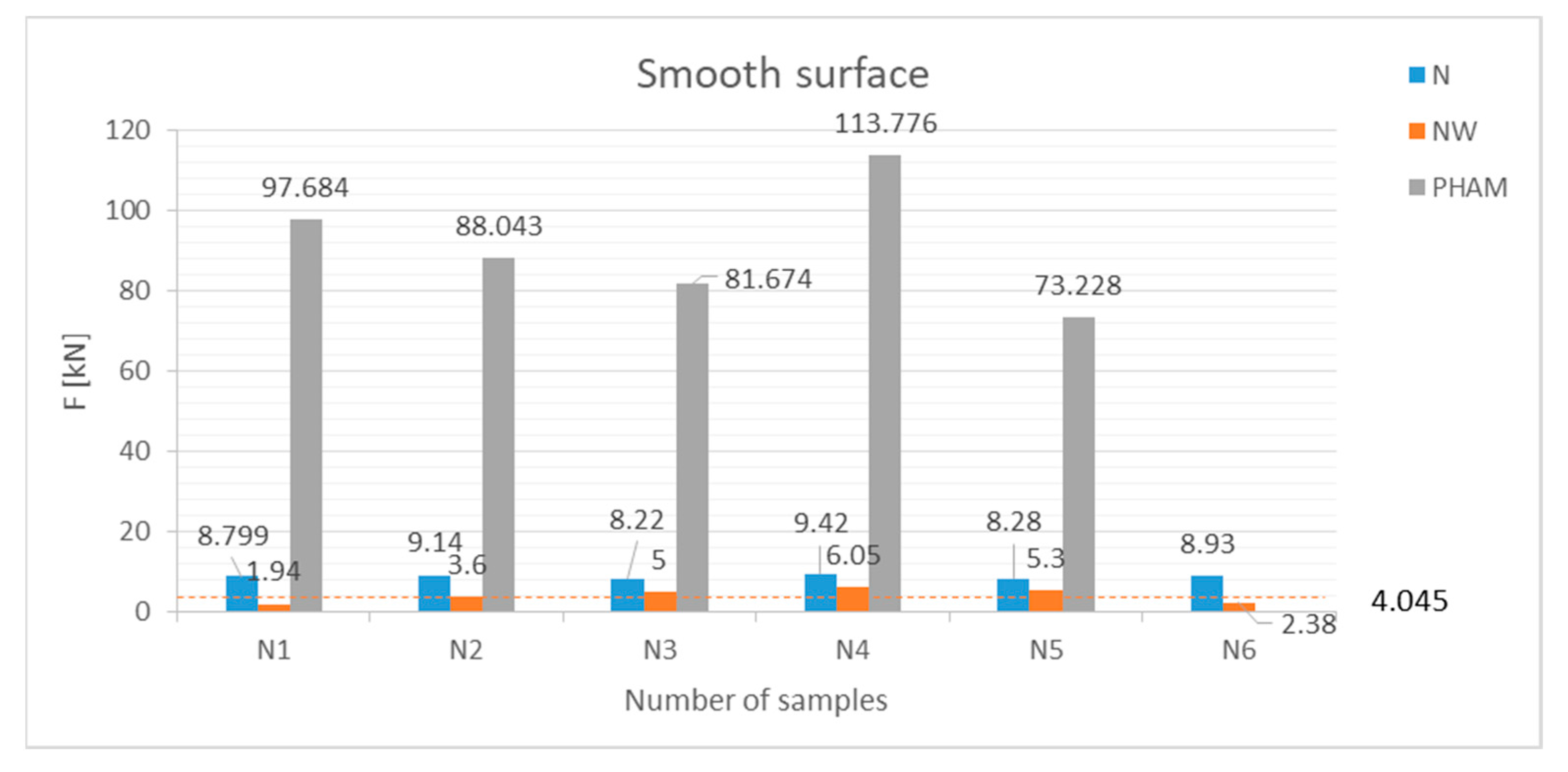
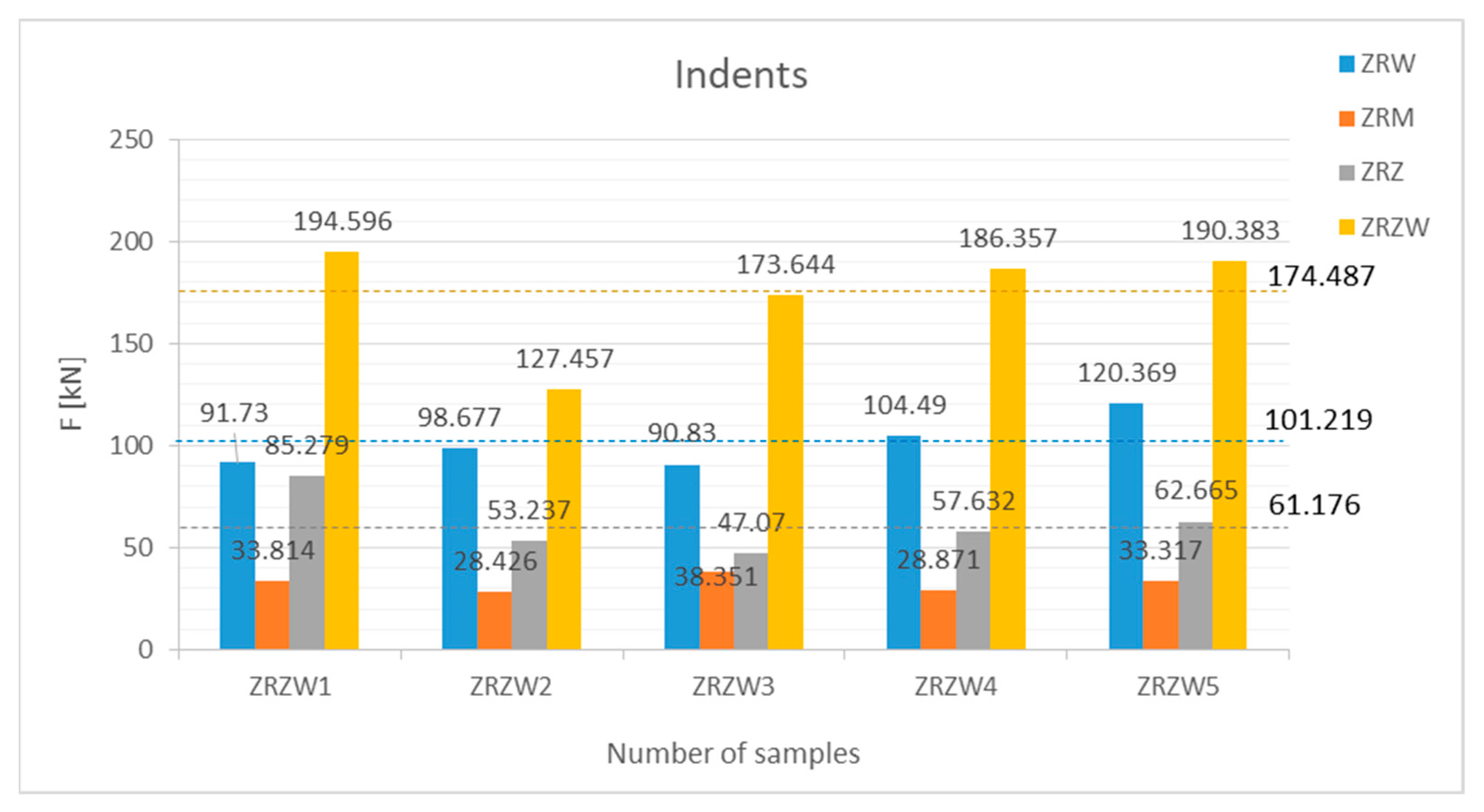

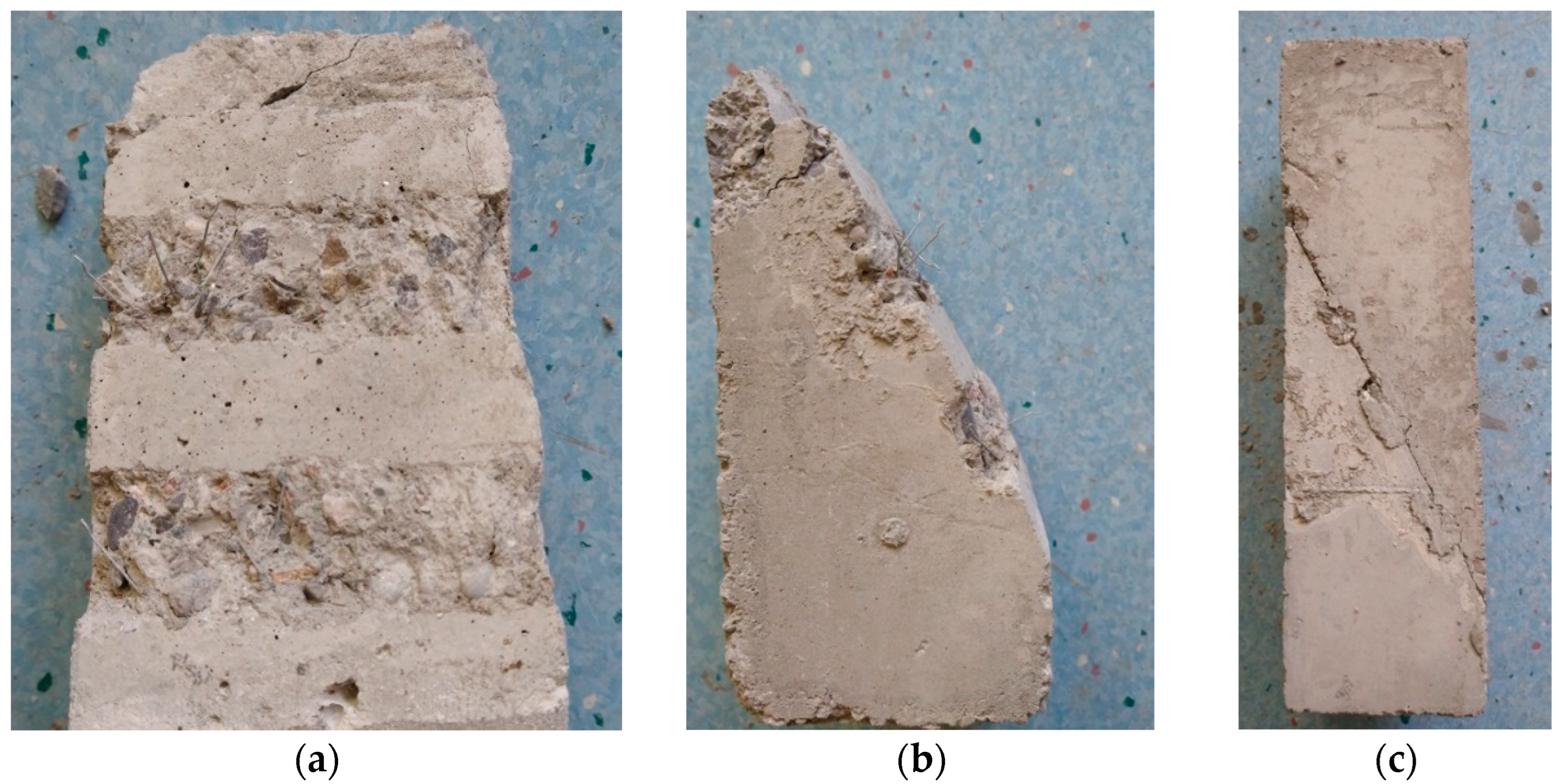
| Design of the Mixtures | Recipe I [kg/m3] | Recipe II [kg/m3] | Recipe III [kg/m3] | Recipe IV [kg/m3] | Recipe V [kg/m3] |
|---|---|---|---|---|---|
| Recipe | MBE | ZBE | MBE + Fibres | B20 | WU Concrete |
| Aggregate 0/8 mm | 910 | 910 | 910 | * | * |
| Aggregate 8/16 mm | 685 | 685 | 685 | * | * |
| Water | 200 | 200 | 200 | * | * |
| Portland cement mixture CEM II/B-M (S-V) | 400 | - | 400 | * | * |
| Portland slag cement CEM II/B-S | - | 400 | - | * | * |
| Plasticizer Den Braven | 4.5 | 4.5 | 4.5 | * | * |
| Water/Cement | 0.5 | 0.5 | 0.5 | * | * |
| Dramix 3D Fibres | - | - | 60 | * | * |
| Series | Recipe | Number of Samples in One Series | fck,cube,test [MPa] − Average Value |
|---|---|---|---|
| 1 | B20 | 7 | 29.82 |
| 2 | WU concrete | 6 | 37.49 |
| 3 | MBE | 3 | 21.80 |
| 4 | ZBE | 8 | 29.71 |
| 5 | MBE + steel fibres | 6 | 22.68 |
| Series Number | Denotation of the Series | Surface Modification | Bottom Part of the Samples | Upper Part of the Samples | Number of Samples in Each Series |
|---|---|---|---|---|---|
| 1 | N | Smooth from the formwork | B20 | B20 | 6 |
| 2 | NW | Smooth from the formwork, 48 h water bath | B20 | B20 | 6 |
| 3 | ZRM | Indents | B20 | MBE | 5 |
| 4 | ZRW | Indents | B20 | WU concrete | 5 |
| 5 | ZRZW | Indents | WU concrete | ZBE | 5 |
| 6 | ZRZ | Indents | B20 | ZBE | 5 |
| 7 | ZZM | Notches | B20 | MBE | 5 |
| 8 | ZZZ | Notches | B20 | ZBE | 5 |
| 9 | DRPL | Notches | B20 | MBE + steel fibres | 5 |
| 10 | PHAM | Smooth + adhesion layer | B20 | ZBE | 5 |
| 11 | VZ | V-shaped indents | B20 | ZBE | 5 |
| Series Number | Denotation of the Series | Fmax | ||
|---|---|---|---|---|
| Average Value [kN] | Standard Deviation [kN] | Coefficient of Variation | ||
| 1 | N | 8.798 | 0.530 | 0.280 |
| 2 | NW | 4.045 | 1.465 | 2.147 |
| 3 | ZRM | 32.555 | 4.633 | 21.467 |
| 4 | ZRW | 101.219 | 12.507 | 156.43 |
| 5 | ZRZW | 174.487 | 28.896 | 835.01 |
| 6 | ZRZ | 61.1766 | 6.622 | 43.860 |
| 7 | ZZM | 73.555 | 5.820 | 33.882 |
| 8 | ZZZ | 190.448 | 6.139 | 37.689 |
| 9 | DRPL | 85.808 | 7.999 | 63.986 |
| 10 | PHAM | 90.881 | 17.483 | 305.68 |
| 11 | VZ | 66.918 | 16.510 | 272.60 |
| Series Number | Denotation of the Series | Fmax [kN] | ccal [MPa] Calculated from Experimental Measurements | ccode [MPa] Code Values Given in [6] | μ [MPa] Standard Values Given in [6] | Percentage Difference ccal/ccode | Standard Deviation of Cohesion σc |
|---|---|---|---|---|---|---|---|
| 1 | N | 8.798 | 0.24 | 0.20 | 0.6 | 120.0% | 0.0153 |
| 2 | NW | 4.045 | 0.11 | 0.20 | 0.6 | 55.00% | 0.0423 |
| 3 | ZRM | 32.555 | 0.83 | 0.40 * | 0.7 | 207.50% | 0.1337 |
| 4 | ZRW | 101.219 | 2.61 | 0.40 * | 0.7 | 652.50% | 0.3610 |
| 5 | ZRZW | 174.487 | 4.5 | 0.40 * | 0.7 | 1125.00% | 0.8341 |
| 6 | ZRZ | 61.1766 | 1.57 | 0.40 * | 0.7 | 392.50% | 0.1911 |
| 7 | ZZM | 73.555 | 1.53 | 0.50 | 0.9 | 306.00% | 0.1680 |
| 8 | ZZZ | 190.448 | 3.96 | 0.50 | 0.9 | 792.00% | 0.1772 |
| 9 | DRPL | 85.808 | 1.78 | 0.50 | 0.9 | 356.00% | 0.2309 |
| 10 | PHAM | 90.881 | 2.62 | 0.20 ** | 0.6 ** | 1310.00% | 0.5047 |
| 11 | VZ | 66.918 | 1.72 | 0.40 * | 0.7 | 430.0% | 0.4766 |
Disclaimer/Publisher’s Note: The statements, opinions and data contained in all publications are solely those of the individual author(s) and contributor(s) and not of MDPI and/or the editor(s). MDPI and/or the editor(s) disclaim responsibility for any injury to people or property resulting from any ideas, methods, instructions or products referred to in the content. |
© 2025 by the authors. Licensee MDPI, Basel, Switzerland. This article is an open access article distributed under the terms and conditions of the Creative Commons Attribution (CC BY) license (https://creativecommons.org/licenses/by/4.0/).
Share and Cite
Farbák, M.; Vavruš, M.; Koteš, P.; Adamczak-Bugno, A. Shear Analysis of “Concrete-to-Concrete” Contact as an Important Parameter for Strengthening Concrete Structures. Buildings 2025, 15, 3889. https://doi.org/10.3390/buildings15213889
Farbák M, Vavruš M, Koteš P, Adamczak-Bugno A. Shear Analysis of “Concrete-to-Concrete” Contact as an Important Parameter for Strengthening Concrete Structures. Buildings. 2025; 15(21):3889. https://doi.org/10.3390/buildings15213889
Chicago/Turabian StyleFarbák, Matúš, Martin Vavruš, Peter Koteš, and Anna Adamczak-Bugno. 2025. "Shear Analysis of “Concrete-to-Concrete” Contact as an Important Parameter for Strengthening Concrete Structures" Buildings 15, no. 21: 3889. https://doi.org/10.3390/buildings15213889
APA StyleFarbák, M., Vavruš, M., Koteš, P., & Adamczak-Bugno, A. (2025). Shear Analysis of “Concrete-to-Concrete” Contact as an Important Parameter for Strengthening Concrete Structures. Buildings, 15(21), 3889. https://doi.org/10.3390/buildings15213889







